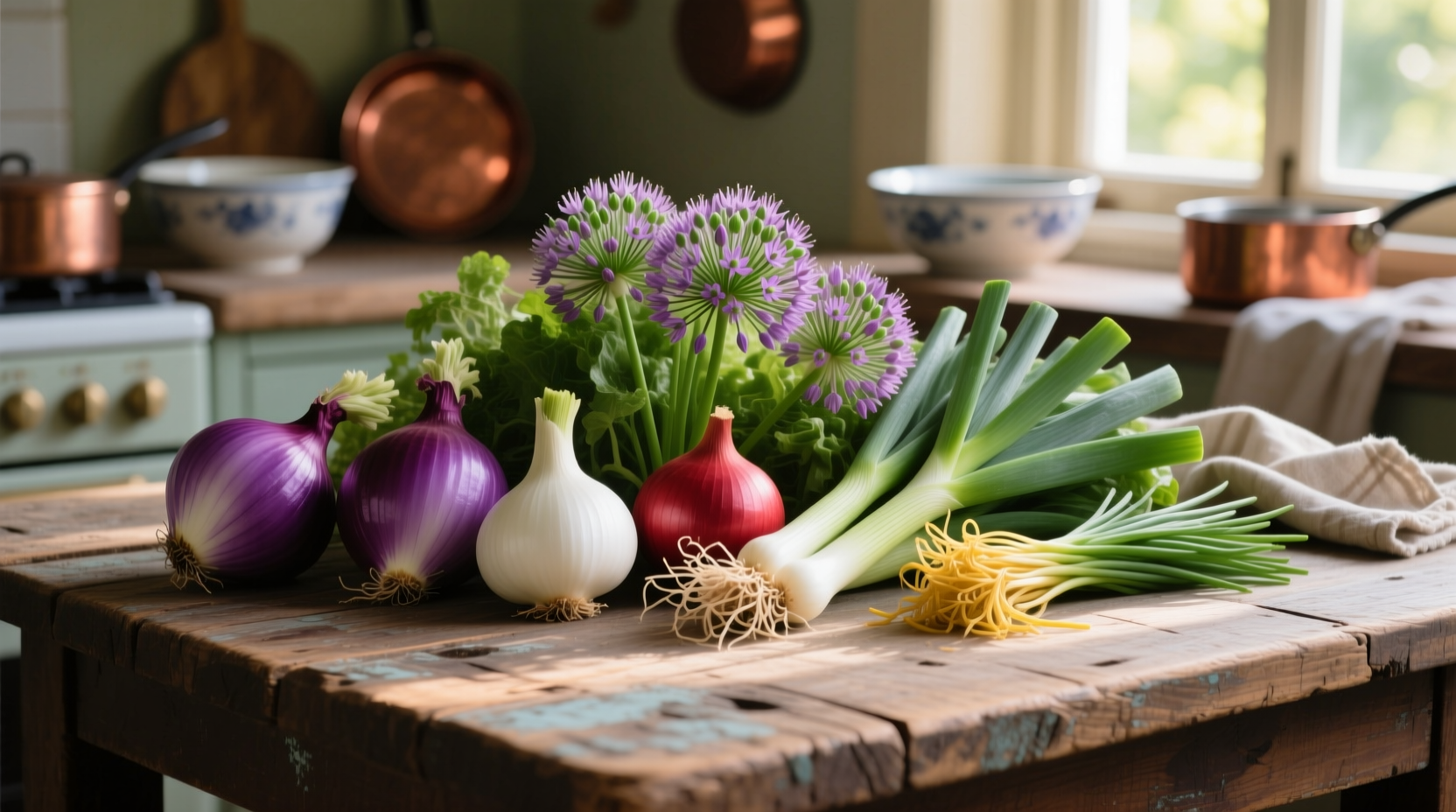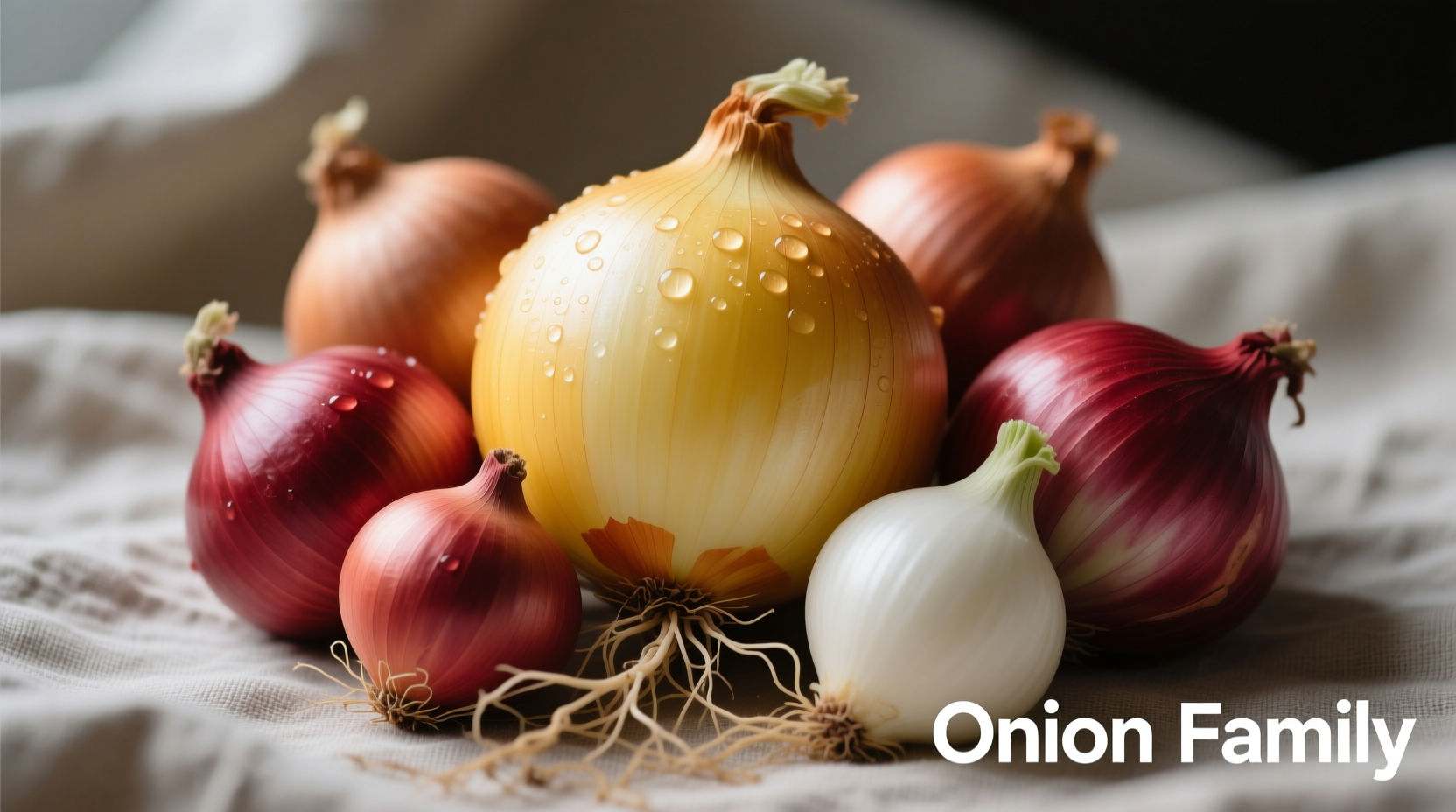The onion family, scientifically known as Allium, includes garlic, leeks, shallots, chives, scallions, and onions themselves. These vegetables share distinctive sulfur compounds that create their pungent flavors and aromas while delivering significant health benefits including cardiovascular support and anti-inflammatory properties.
Understanding which vegetables belong to the onion family transforms your cooking, gardening, and nutritional choices. Whether you're substituting ingredients in recipes, planning your garden layout, or maximizing health benefits, recognizing these botanical relationships provides practical advantages you can apply immediately.
What Defines the Onion Family (Allium)?
The Allium genus contains over 850 species of bulbous plants characterized by their distinctive sulfur-containing compounds. When you cut or crush these vegetables, enzymes release volatile sulfur compounds that create their signature pungency. This same chemical reaction produces the health-promoting compounds that make these vegetables nutritional powerhouses.
According to the USDA Plants Database, Allium belongs to the Amaryllidaceae family and demonstrates specific botanical features including:
- Bulb or rhizome-based growth structure
- Hollow, cylindrical leaves
- Characteristic sulfur-based flavor compounds
- Flowers arranged in umbel formations

Complete List of Common Onion Family Vegetables
| Common Name | Scientific Name | Distinctive Characteristics |
|---|---|---|
| Onion | Allium cepa | Bulb with concentric layers, sharp flavor when raw |
| Garlic | Allium sativum | Compound bulb divided into cloves, strongest sulfur compounds |
| Leek | Allium ampeloprasum var. porrum | Elongated white stem, milder flavor profile |
| Shallot | Allium cepa var. aggregatum | Cluster-forming bulbs, delicate sweet-sharp flavor |
| Chives | Allium schoenoprasum | Hollow stems, mild onion flavor, used as herb |
| Scallion/Green Onion | Allium fistulosum | No developed bulb, mild flavor throughout plant |
Culinary Substitutions Within the Onion Family
Knowing these vegetables share botanical origins helps you make intelligent substitutions in recipes. While each has unique flavor intensity, they generally work as substitutes with some adjustments:
- Use 1 shallot for every small onion (milder flavor)
- Substitute 3 garlic cloves for 1 teaspoon garlic powder
- Replace onions with leeks in soups and stews (use white and light green parts)
- Use chives as garnish when raw onion would be too strong
The National Institutes of Health confirms that cooking methods significantly affect the bioactive compounds in Allium vegetables. Sautéing releases different beneficial compounds than raw consumption, while prolonged boiling reduces certain health-promoting elements.
Nutritional Power: Why the Onion Family Matters for Health
Allium vegetables deliver impressive health benefits thanks to their unique organosulfur compounds. Research from the Harvard T.H. Chan School of Public Health shows regular consumption associates with:
- Reduced risk of cardiovascular disease through blood pressure regulation
- Anti-inflammatory effects that may reduce cancer risk
- Improved bone density, particularly in women
- Antimicrobial properties that support immune function
The compound allicin, most abundant in crushed garlic, demonstrates particularly strong medicinal properties. For maximum benefit, let chopped garlic sit for 10 minutes before cooking to allow full allicin development.
Gardening Considerations for Onion Family Vegetables
If you grow your own food, understanding these botanical relationships prevents common gardening mistakes. The Cornell University Cooperative Extension recommends:
- Rotating Allium crops every 3-4 years to prevent soil-borne diseases
- Avoiding planting near legumes (beans, peas) which inhibit growth
- Pairing with carrots, beets, or strawberries for beneficial companion planting
- Providing well-drained soil with consistent moisture
These vegetables share common pests like onion maggots and thrips, so rotating locations helps break pest cycles. Their strong scent actually repels some insects, making them valuable companions for other vegetables.
Practical Kitchen Applications
Maximize flavor and minimize tears with these professional techniques:
- Chill onions for 30 minutes before cutting to reduce volatile compounds
- Use a sharp knife to minimize cell damage and pungency release
- Soak cut onions in ice water for 10 minutes to mellow sharpness
- Add raw onions to dishes at the end of cooking for maximum flavor impact
- Store whole onions in cool, dry, dark places (never refrigerate)
Understanding the onion family's botanical relationships helps you make smarter choices whether you're meal planning, grocery shopping, or designing your garden. These vegetables offer remarkable versatility across culinary applications while delivering significant health benefits that make them essential components of a balanced diet.
Frequently Asked Questions
Are green onions part of the onion family?
Yes, green onions (scallions) belong to the Allium family with the scientific name Allium fistulosum. They're harvested before bulb formation and offer a milder flavor than mature onions while containing the same beneficial sulfur compounds.
Can I substitute leeks for onions in recipes?
Yes, leeks make excellent onion substitutes, particularly in soups and stews. Use the white and light green parts only, and remember leeks have a milder flavor, so you may need 50-75% more by volume to achieve similar flavor intensity.
Why do onion family vegetables make you cry?
When you cut Allium vegetables, enzymes release syn-propanethial-S-oxide, a volatile sulfur compound that reacts with moisture in your eyes to form mild sulfuric acid. This irritates the eyes, triggering tear production as a protective response.
What's the difference between shallots and onions?
Shallots (Allium cepa var. aggregatum) grow in clusters rather than single bulbs, have a more delicate flavor with subtle garlic notes, and contain higher concentrations of certain flavonoids. They're excellent for raw applications and delicate sauces where regular onions would be too strong.
Do all onion family vegetables have similar health benefits?
While all Allium vegetables contain beneficial organosulfur compounds, their concentrations vary. Garlic contains the highest levels of allicin, while onions are particularly rich in quercetin. Each offers unique phytonutrient profiles, so consuming a variety provides the broadest health benefits.











 浙公网安备
33010002000092号
浙公网安备
33010002000092号 浙B2-20120091-4
浙B2-20120091-4